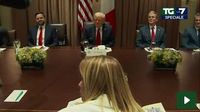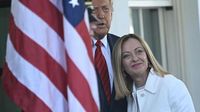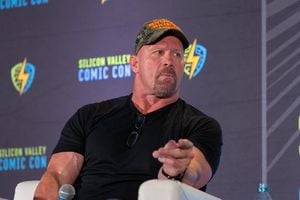On April 17, 2025, Giorgia Meloni, the Italian Prime Minister, arrived at the White House for a highly anticipated meeting with U.S. President Donald Trump. This meeting marks a significant moment in U.S.-Italy relations, highlighting Meloni's role as a key figure in bridging the gap between the United States and the European Union.
Upon her arrival, Meloni was warmly greeted by Trump, who praised her leadership, stating, "She is a great leader doing an exceptional job in Italy." This sentiment underscores the strong rapport between the two leaders, which has been characterized as a "very special relationship" by U.S. officials.
The primary focus of their discussions was the contentious issue of tariffs. Both leaders expressed optimism about reaching an agreement that would prevent a trade war between the U.S. and the EU. Trump stated he is "very confident about a trade agreement with the EU," emphasizing that discussions are progressing well. He assured that there would be "very few problems" in reaching an agreement, noting, "We have something that everyone wants." Meloni echoed this sentiment, expressing her belief that they could find common ground on tariffs, saying, "We need to speak frankly about reciprocal needs and find common ground on tariffs."
During their meeting, Trump also addressed the ongoing conflict in Ukraine. He remarked, "I don't think Zelensky is responsible for the war, but I'm not exactly thrilled that the war started. I'm not a big fan of his." However, he acknowledged Italy's supportive role in aiding Ukraine, stating, "Italy has been very helpful in supporting Ukraine." Meloni highlighted the interconnectedness of their economies, revealing that Italian companies are set to invest $10 billion in the U.S., further solidifying economic ties.
In response to questions about sending Italian soldiers to Ukraine, Trump indicated that it would ultimately be Italy's decision but welcomed the idea of a peace mission. "Peace missions are always welcome," he stated, reflecting a collaborative approach to international relations.
As the conversation shifted to defense spending, Meloni announced that Italy would reach the NATO target of 2% of GDP for military expenditures, which she plans to confirm at the upcoming NATO summit. "We are convinced that everyone must do more," she stated, emphasizing the need for increased defense contributions among NATO allies. Trump responded affirmatively, saying, "2% is never enough," reiterating his call for greater military spending among NATO countries.
In addition to tariffs and defense, the leaders discussed broader geopolitical issues, including relations with China. Trump expressed confidence in securing a favorable trade agreement with China, stating, "No one can compete with us; we will reach an agreement with China, you'll see." This reflects a strategic approach to U.S. foreign policy, aimed at countering China's influence globally.
Meloni's visit also included an invitation for Trump to visit Italy for an official meeting with EU leaders, which he accepted. She expressed optimism about the potential for collaboration, saying, "I believe we can reach an agreement," and emphasized the importance of open dialogue between the U.S. and Europe.
The meeting's agenda was carefully planned, beginning with a private lunch at 12:05 PM (18:05 in Italy) followed by a bilateral discussion in the Oval Office. This structured approach was designed to facilitate in-depth conversations on critical issues without the distraction of a joint press conference.
As the discussions unfolded, Trump took the opportunity to criticize Federal Reserve Chairman Jerome Powell, stating he is "too slow in lowering interest rates." This remark highlights the ongoing tensions surrounding U.S. economic policy and its implications for international trade.
Overall, Meloni's visit to the White House signifies a pivotal moment in U.S.-Italy relations, with both leaders expressing a commitment to strengthening ties through trade agreements and collaborative efforts on global issues. As they work towards finding common ground on tariffs and defense spending, the potential for a more united front between the U.S. and the EU appears promising.
The discussions held on April 17 not only reflect the current state of international relations but also set the stage for future collaborations that could shape the geopolitical landscape in the coming years.







